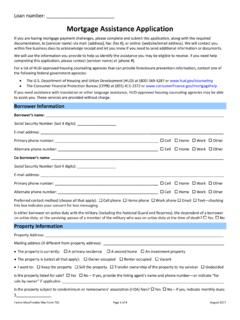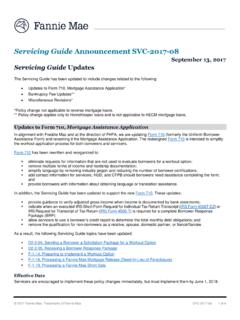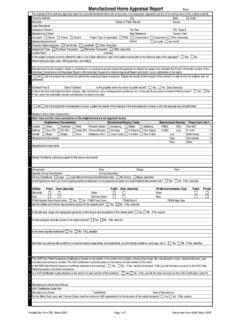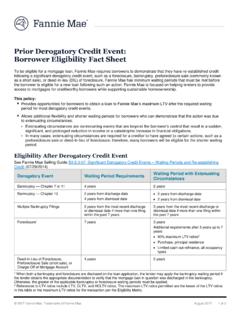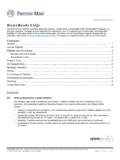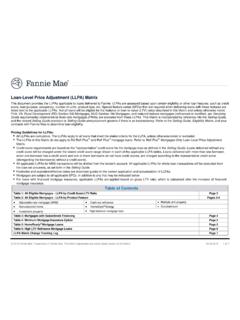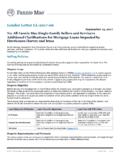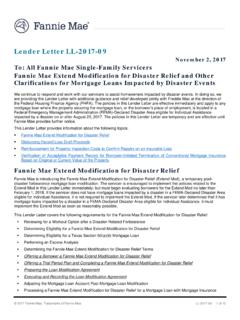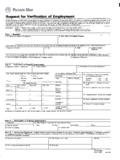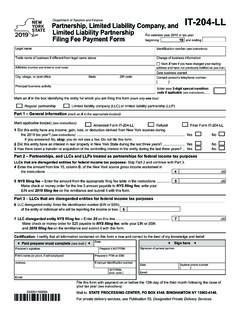Transcription of Lender Letter LL-2015-02 - Fannie Mae
1 Lender Letter LL- 2015 -02. February 04, 2015 . To: All Fannie Mae Single-Family Sellers Appraisal Tools, Processes, and Policies The purpose of this Lender Letter is to provide clarifications and additional information regarding Fannie Mae's valuation-related tools and policy updates announced within the past 12 to 18 months. These include Collateral Underwriter (CU ), Appraiser Quality Monitoring (AQM), and updates to the Property Eligibility and Appraisal Requirements section of the Selling Guide. With such a significant body of changes, it is inevitable that there would be some misconceptions and misinformation among lenders and appraisers. This communication is intended to provide facts, context, and clarifications. Collateral Underwriter CU is a proprietary model-driven tool developed by Fannie Mae that provides an automated appraisal risk assessment to support proactive management of appraisal quality.
2 As previously announced, Fannie Mae is making CU available to Fannie Mae-approved lenders in 2015 to provide transparency and to help lenders more effectively and efficiently identify potential issues with appraisals. A significant amount of CU information and training is provided on Fannie Mae's CU web page, including a fact sheet, FAQs, and On-Demand eLearning courses that are available 24/7. Fannie Mae highly recommends that industry stakeholders in particular, lenders and real estate appraisers take advantage of the information provided on the website to become familiar with CU. There has been much discussion and anticipation in the industry since the October 2014 announcement regarding the 2015 release of CU to Fannie Mae lenders. As a result, Fannie Mae believes it is important to provide some facts related to CU in an effort to clarify some of the misstatements and misconceptions that exist.
3 The use of CU is voluntary and at no cost to the Lender . CU is a Fannie Mae only risk management tool. CU does not make a credit decision and the Lender may not use CU to make a credit decision. CU does not accept or reject appraisal reports or characterize an appraisal as good or bad. The CU risk score and messages pertain to risk and identify potential defects in the appraisal report. The Lender is not obligated to clear or override the CU messages. The messages are meant to be used as red flag messages that lenders should use to assist with their appraisal analysis and inform their decisions based on a complete analysis and understanding of the appraisal report. CU does not provide an estimate of value to the Lender . CU provides a numerical risk score from to , with 1 indicating the lowest risk and 5 indicating the highest risk.
4 Risk flags and messages identify risk factors and specific aspects of the appraisal that may require further attention. 2015 Fannie Mae. Trademarks of Fannie Mae. LL- 2015 -02 Page 1. CU's selection of comparable sales considers the relevance of each potential comparable sale based on physical similarity, time, and distance. The selection process is not based on the relative risk or sale price of a comparable sale nor is there a lower is best approach. In fact, CU may assign a high risk score to an appraisal when the model identifies alternative sales that are potentially more relevant than the comparable sales used by the appraiser, regardless of whether the alternative sales are higher or lower in price. CU considers under-valuation and over-valuation risk, based in part on factors such as the relevance of the comparable sales chosen, and whether or not the appraiser made appropriate adjustments when warranted.
5 CU takes location into account using Census Block Group levels, which are subsets of Census Tracts. This is the most viable proxy for location in the absence of standardized neighborhood definitions, and more effective than use of arbitrary distance guidelines. Fannie Mae is not suggesting that appraisers use Census Block Groups to define comparable search areas, but appraisers remain responsible for indicating when comparables are from outside of the subject neighborhood and for addressing any differences. The risk analysis performed by CU is for exclusive use by the Lender in their analysis of the appraisal report. After completing a thorough review, a Lender should be able to have constructive dialogue with the appraiser to resolve specific appraisal questions or concerns. Although the Lender may use output from Collateral Underwriter to inform its dialogue with appraisal management companies and appraisers regarding appraisals they supplied, the CU license terms prohibit providing these entities with copies or displays of Fannie Mae reports that contain CU findings, including without limitation the CU Print Report, the UCDP Submission Summary Report, or any other CU report.
6 The Lender must not make demands or provide instructions to the appraiser based solely on automated feedback. Also the CU license terms prohibit using it in a manner that interferes with the independent judgment of an appraiser. Fannie Mae expects the Lender to use human due diligence in combination with the CU feedback, and will actively follow up with lenders who are reported to be asking appraisers to change their reports based on CU feedback without any further due diligence. Fannie Mae does not instruct or suggest to lenders that they ask the appraiser to address all or any of the 20 comparables that are provided by CU for most appraisals. It is also not Fannie Mae's expectation that appraisals should contain only CU's top-ranked comparable sales. In the majority of cases, there may be no material difference between comparable sales utilized by the appraiser and those identified by CU.
7 Before asking the appraiser to consider any alternative sales, it is imperative that the Lender analyze the relevance of the sale and determine if the use of such sale would result in any material change to the appraisal report. If the Lender determines that there would be no material change, then they should not ask the appraiser to make revisions. Fannie Mae expects CU to enable lenders to accept appraisals as is with greater confidence. CU is available only to approved Fannie Mae lenders, and is not available to other industry participants such as appraisers for several reasons, including: Fannie Mae's contractual relationship is with approved lenders. Based on the Lender 's representations and warranties in accordance with the Selling Guide, it is up to the Lender to determine which appraisals they submit to the Uniform Collateral Date Portal (UCDP) and ultimately whether to sell a particular loan to Fannie Mae.
8 Additionally, it is their responsibility to underwrite the appraisal to determine acceptability with respect to property eligibility and other Fannie Mae requirements. CU requires an appraisal submission to UCDP in order to run; it is not based on entering an address and retrieving market data. CU is an appraisal risk management tool. It is not the first product of its kind and is not the first automated technology that lenders have used to assist with their quality control processes. Lenders have long been using 2015 Fannie Mae. Trademarks of Fannie Mae. LL- 2015 -02 Page 2. automated products, checklists, and overlays, which may have led to unnecessary correction requests to the appraiser. Appraisers who make a good faith effort to provide accurate data, select appropriate comparables, make market-based adjustments, and give weight to the most relevant comparables should feel no significant negative impact as a result of the use of CU.
9 CU can identify issues with appraisal reports, and it can also validate the many appraisal reports that are very well-supported. The net result should be that lenders, AMCs, and appraisers should not expect any significant increase in correction requests or need for rework. Selling Guide Policy Updates Adjustments to Comparable Sales In the December, 2014 Selling Guide update, Fannie Mae removed a long-standing guideline that when adjustments to the comparable sales exceeded 15% net and 25% gross, the appraiser was required to provide an explanation as to why the comparable was chosen for use in the appraisal report. This requirement for commentary was based on the premise that the best comparable would require the fewest adjustments. While this premise remains true in theory, the guideline for 15% net and 25% adjustments was widely implemented as an eligibility hard stop due to many rules-based automated review systems.
10 Analysis of appraisals submitted to UCDP made it clear that many appraisal reports never exceeded the 15% or 25%. guideline the focus of many appraisers had become keeping the amount of the adjustments within the guidelines instead of reflecting actual market reaction for specific characteristic(s). To support the decision-making process to remove this guideline, Fannie Mae analyzed 700,000 appraisals submitted to Fannie Mae in Q1 2014, including analysis of more than million comparable sales. The charts below reflect the results of the analysis. Nearly 95% of comps analyzed had net adjustments less than 15%, suggesting that appraisers strictly adhered to the net adjustments guideline. Fannie Mae's concern is that the adjustments might be artificially low. 20% Net Adjustment Distribution 16% % of Comparables 12% 8% 4% 0%.
